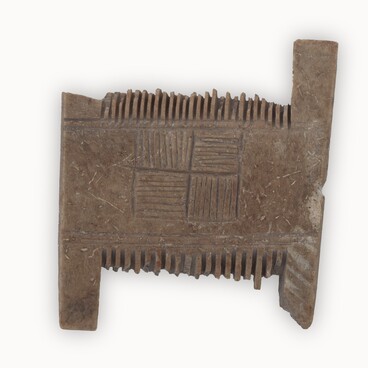The Kursk Regional Museum of Archaeology presents a cross pendant of the mid–18th — early 19th centuries. The cross was discovered by the museum staff in 2001 during rescue excavations of the site and the defensive rampart of the Kapystichi ancient settlement located in the Rylsky district of the Kursk region.
It has been established that the late 9th — early 11th century is the earliest stage in the history of the site, as evidenced by the remains of utility and residential buildings belonging to the Romensky culture (early medieval Slavic archaeological culture of the 8th–10th centuries). In addition, since the 17th century services were held at the church (first wooden, then brick) on the site of the settlement, near which a parish cemetery appeared.
33 burials were fully or partially examined in the area of the excavation on the site and on the rampart of the settlement. Six of the burials, probably the most recent, were embedded in the slopes of the rampart. It was possible to determine the sex and approximate age of the buried people in 11 cases. On the whole in this area of the cemetery there were 3 children’s and 21 adult burials, four female and seven male burials. Only two graves (No. 8 and no. 32) contained cross pendants, three contained jewelry (glass earrings, remnants of headdresses), and two had metal clothing accessories (buttons).
Direct analogues of the cross from the museum collection are held in the Russian Museum of Ethnography. Such crosses appeared in the late 17th century, but in this case, the mid–18th — early 19th century should be considered the most likely dating of the find. Interestingly, among the finds are crosses, typical of Old Believers. Also noteworthy is the absence of crosses in most of the graves suitable for analysis. A similar situation has already been registered earlier in the study of burials of the 18th–19th centuries. Some experts believe that this can be explained by the fact that over time it became less popular to leave metal objects in graves during burial rituals, following popular beliefs. It was allowed to leave the copper cross in the grave, but it was often replaced by a wooden or wax one. By the 19th century, metal crosses were practically never used in the funeral rites. The predominance of samples dating back to the 17th–18th centuries among the crosses of Kapystichi cemetery, confirms this point of view.
It has been established that the late 9th — early 11th century is the earliest stage in the history of the site, as evidenced by the remains of utility and residential buildings belonging to the Romensky culture (early medieval Slavic archaeological culture of the 8th–10th centuries). In addition, since the 17th century services were held at the church (first wooden, then brick) on the site of the settlement, near which a parish cemetery appeared.
33 burials were fully or partially examined in the area of the excavation on the site and on the rampart of the settlement. Six of the burials, probably the most recent, were embedded in the slopes of the rampart. It was possible to determine the sex and approximate age of the buried people in 11 cases. On the whole in this area of the cemetery there were 3 children’s and 21 adult burials, four female and seven male burials. Only two graves (No. 8 and no. 32) contained cross pendants, three contained jewelry (glass earrings, remnants of headdresses), and two had metal clothing accessories (buttons).
Direct analogues of the cross from the museum collection are held in the Russian Museum of Ethnography. Such crosses appeared in the late 17th century, but in this case, the mid–18th — early 19th century should be considered the most likely dating of the find. Interestingly, among the finds are crosses, typical of Old Believers. Also noteworthy is the absence of crosses in most of the graves suitable for analysis. A similar situation has already been registered earlier in the study of burials of the 18th–19th centuries. Some experts believe that this can be explained by the fact that over time it became less popular to leave metal objects in graves during burial rituals, following popular beliefs. It was allowed to leave the copper cross in the grave, but it was often replaced by a wooden or wax one. By the 19th century, metal crosses were practically never used in the funeral rites. The predominance of samples dating back to the 17th–18th centuries among the crosses of Kapystichi cemetery, confirms this point of view.





